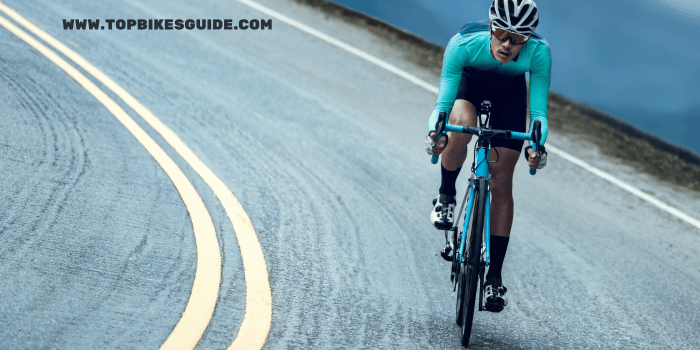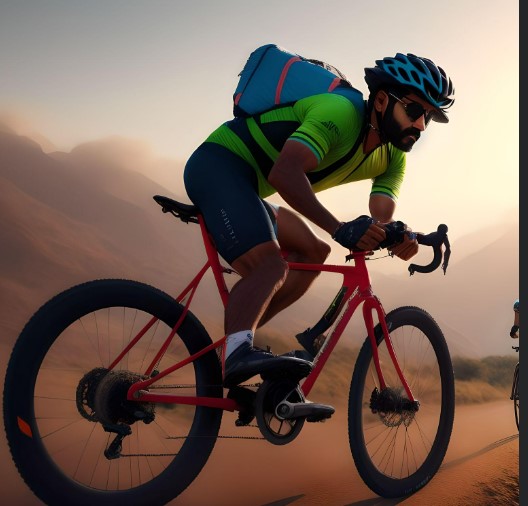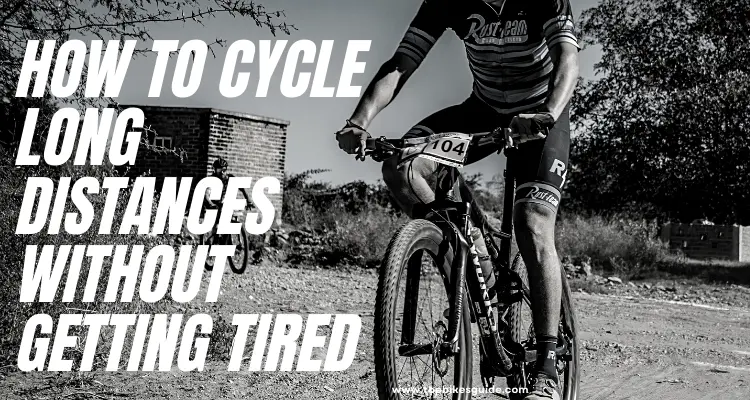If you’re looking to cycle long distances without getting tired, there are a few key things you need to keep in mind. First and foremost, it’s important to make sure that you’re properly fueling your body with the right foods and fluids. This means eating a balanced diet that includes plenty of carbohydrates, protein, and healthy fats, as well as drinking enough water to stay hydrated.
Another important factor to consider is your cycling technique. When you’re riding long distances, it’s important to maintain a steady pace and avoid sudden bursts of speed or intensity. This will help you conserve your energy and prevent muscle fatigue. Additionally, you should focus on maintaining good posture and form while cycling, which can help reduce strain on your muscles and joints.
Preparing Your Body for Long Distance Cycling
Long distance cycling is a great way to stay fit and explore new places, but it can be challenging if you’re not prepared. To cycle long distances without getting tired, you need to train your body and mind to endure the physical and mental demands of cycling. Here are some tips to help you prepare your body for long distance cycling.
Proper Training Techniques
Training is the key to building endurance and increasing your energy levels. Start by setting a goal for yourself, whether it’s a certain distance or a specific time frame. Then, gradually increase your mileage each week, aiming for a 10% increase in distance or time each week. Incorporate interval training and hill repeats to build strength and improve your metabolic rate.
Importance of Rest and Recovery
Rest and recovery are just as important as training. Make sure to take rest days to allow your muscles to recover and prevent injury. Get enough sleep each night and stay hydrated throughout the day. Stretch before and after each ride to prevent muscle soreness and improve flexibility.
Nutrition and Hydration
Proper nutrition and hydration are essential for long distance cycling. Eat a balanced diet with plenty of carbohydrates, protein, and healthy fats. Carbohydrates provide energy for your muscles, while protein helps repair and build muscle tissue. Stay hydrated by drinking water and electrolyte-rich fluids throughout the day. Bring snacks like dry fruits, bread, and fruits to keep your energy levels up during long rides. Avoid junk food and high-calorie foods that can slow you down and make you feel sluggish.
By following these tips and incorporating them into your routine, you can prepare your body for long distance cycling and enjoy the ride stress-free. Remember to warm up before each ride, maintain a proper riding position, wear comfortable cycling clothes, and invest in lightweight gear to reduce wind resistance. With time and practice, you’ll be able to cycle long distances without getting tired.
Choosing the Right Equipment
When it comes to cycling long distances, having the right equipment can make all the difference. Here are some things to consider when choosing your equipment.
Necessary Equipment
There are a few pieces of equipment that are essential for any long-distance ride. These include:
- Bike: Obviously, you’ll need a bike to cycle long distances. Choose a bike that is comfortable and fits you well. Consider a touring or endurance bike, which are designed for long distances.
- Helmet: Protect your head with a helmet. Look for one that is comfortable and fits properly.
- Pump: You’ll need to inflate your tires before each ride. A portable pump is a must-have.
- Repair kit: Flat tires happen. Be prepared with a repair kit that includes tire levers, patches, and a spare tube.
Unnecessary Equipment
There are some pieces of equipment that you may think you need, but are actually unnecessary. These include:
- Backpack: Carrying a heavy backpack can cause discomfort and affect your balance. Consider using panniers instead.
- Cycling-specific clothes: While cycling shorts and jerseys can be comfortable, they are not necessary. Wear clothes that are comfortable and breathable.
- Saddle: A comfortable saddle is important, but don’t spend a lot of money on one. You can always add a gel cover for extra comfort.
Gearing
Gearing is important for long-distance cycling. Look for a bike with a wide range of gears, including low gears for climbing hills. This will help you conserve energy and reduce fatigue.
Bike Fit
A bike that doesn’t fit properly can cause discomfort and affect your performance. Make sure your bike is adjusted to fit you properly. Consider getting a professional bike fit to ensure the best fit possible.
Remember, having the right equipment is important, but it’s not everything. Proper training, nutrition, and hydration are also important factors in cycling long distances.
15 TIPS TO CYCLE LONG DISTANCES WITHOUT GETTING TIRED
Cycling long distances can be a daunting task, especially if you’re not prepared for it. However, with the right techniques and mindset, you can conquer any distance with ease. Here are 15 tips to help you cycle long distances without getting tired.

Maintain Proper Riding Position
Maintaining a proper riding position is crucial for cycling long distances without getting tired. Keep your back straight, elbows slightly bent, and your head up. This will help you breathe easier and prevent muscle fatigue.
Use The Right Breathing Technique – Breathing With Diaphragm
Breathing with your diaphragm helps you take in more oxygen and release more carbon dioxide. This technique will help you ride longer and harder without getting tired.
Don’t Take Unnecessary Equipment While Cycling
Carrying unnecessary equipment can weigh you down and make it harder to cycle long distances. Pack only what you need, and make sure it’s lightweight.
Pace Yourself
Pacing yourself is essential for long-distance cycling. Start slow and gradually increase your speed. This will help you conserve energy and prevent muscle fatigue.
Choose the Right Clothes Made for Cycling
Choosing the right clothes made for cycling can make a big difference in your performance. Wear clothes that are breathable, moisture-wicking, and comfortable.
Goal For 7 Minutes a Mile to Not Get Tired
Setting a goal of cycling 7 minutes a mile can help you maintain a steady pace and prevent fatigue. Stick to this goal, and you’ll be able to cycle long distances without getting tired.
Take Foods Rich In Carbohydrates Regularly
Eating foods rich in carbohydrates can provide you with the energy you need to cycle long distances. Bananas are an excellent source of carbohydrates and can help prevent muscle cramps.
Stay Hydrated
Staying hydrated is crucial for long-distance cycling. Drink water regularly, and make sure you have enough water with you on your ride.
Use Gear The Right Way – Peddle Between Gear Changes
Pedaling between gear changes can help you maintain a steady pace and prevent muscle fatigue. Use your gears wisely, and you’ll be able to cycle long distances without getting tired.
Take Some Rest In Between: Drink 350ml Water / 30 Minutes
Taking rest breaks and drinking water regularly can help you stay hydrated and prevent fatigue. Take a break every 30 minutes, and drink 350ml of water.
Ride a Lightweight Bike
Riding a lightweight bike can make a big difference in your performance. Choose a bike that’s lightweight and easy to handle.
Train Regularly
Training regularly is essential for long-distance cycling. Build up your endurance and stamina by cycling regularly.
Pick Your Weather
Picking the right weather conditions can make a big difference in your performance. Avoid cycling in extreme heat or cold, and choose days with mild weather.
Ride With Friends
Riding with friends can make long-distance cycling more enjoyable and less daunting. Join a cycling club or group, and cycle together.
Listen to Music While Riding
Listening to music while riding can help you stay motivated and focused. Choose upbeat music that will keep you energized.
Ride Stress-Free
Riding stress-free is essential for long-distance cycling. Don’t worry about your speed or distance, and enjoy the ride.
By following these tips, you’ll be able to cycle long distances without getting tired. Remember to pace yourself, stay hydrated, and maintain a proper riding position. Check out this following YouTube video by Vaibhav where he explained How to Cycle Long Distances Without Getting Tired
Mental Preparation and Strategies
When it comes to cycling long distances, mental preparation and strategies are just as important as physical training. Here are some mental strategies and distraction techniques to help you push through the fatigue and keep going.
Mental Strategies for Endurance
- Set small goals: Instead of focusing on the entire distance, break it down into smaller goals. For example, focus on reaching the next town or cresting the next hill. This will help you stay motivated and make the distance feel more manageable.
- Positive self-talk: Encourage yourself with positive self-talk. Remind yourself of your strengths and why you started cycling. Tell yourself that you can do it, and that you are strong and capable.
- Visualize success: Visualize yourself crossing the finish line and achieving your goal. This will help you stay motivated and focused on the end result.
Distraction Techniques
- Listen to music: Create a playlist of your favorite upbeat songs to keep you motivated and energized. Music can also help distract you from the physical discomfort and fatigue.
- Ride with friends: Cycling with friends can help make the distance feel less daunting. You can encourage each other and share the experience together.
- Mental games: Play mental games to distract yourself from the physical discomfort. For example, count the number of red cars you see or try to spot different types of birds along the route.
By using these mental strategies and distraction techniques, you can help keep your mind focused and motivated during long-distance cycling. Remember to stay positive, set small goals, and visualize success to help you push through the fatigue and achieve your goals.
Conclusion
In conclusion, cycling long distances can be a challenging yet rewarding experience. By following the tips and techniques outlined in this article, you can improve your endurance and reduce fatigue, allowing you to cycle longer distances without feeling tired.
Remember to start slow and gradually increase your distance and intensity. Proper nutrition and hydration are essential for maintaining energy levels and preventing fatigue. Make sure to fuel up before your ride and stay hydrated throughout.
Pacing yourself and taking breaks when necessary can also help you conserve energy and prevent burnout. Monitor your heart rate and adjust your pace accordingly to prevent overexertion.
Investing in high-quality gear, such as a comfortable saddle, padded shorts, and proper cycling shoes, can also make a significant difference in your comfort and endurance.
By incorporating these tips into your cycling routine, you can push yourself to new limits and achieve your long-distance cycling goals. Happy cycling!
FAQs
What is the best way to warm up before cycling long distances?
The best way to warm up before cycling long distances is to stretch your body and do some basic leg exercises for 15 minutes. This helps activate your muscles and prepare your body for the ride.
How can I maintain proper riding position while cycling long distances?
To maintain proper riding position while cycling long distances, you should adjust your bike’s saddle height and handlebar position to ensure your body is in the right position. You should also keep your back straight and avoid slouching.
Should I take unnecessary equipment with me when cycling long distances?
No, you should not take unnecessary equipment with you when cycling long distances. This can add unnecessary weight to your bike and make the ride more difficult. Only bring the essentials, such as a spare tube, pump, and water bottle.
How can I choose the right clothes for cycling long distances?
To choose the right clothes for cycling long distances, you should opt for breathable and moisture-wicking fabrics that keep you cool and dry. You should also wear padded shorts to reduce friction and prevent chafing.
How can I avoid getting tired while cycling long distances?
To avoid getting tired while cycling long distances, you should pace yourself and aim for a consistent speed. You should also take regular breaks to rest and refuel, and drink plenty of water to stay hydrated.
References
https://solosportsworld.com/cycle-without-getting-tired/
https://www.bicycle-guider.com/cycling-advice/long-distance-cycling/
Also Read: Can We Do Cycling After Dinner? Expert Opinion

A passionate cyclist with an unwavering love for the open road and founder of topbikesguide.com . Energetic and dedicated, this enthusiast embraces the thrill of speed and the freedom of two wheels.

